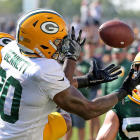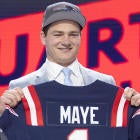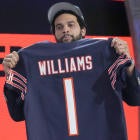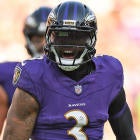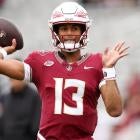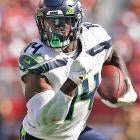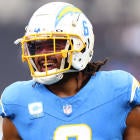Aaron Rodgers has been the Green Bay Packers' starting quarterback since 2008. During that time, the Packers have been one of the NFL's best offenses, both overall and on a yearly basis. In his nine years under center, the Packers have gained the fourth-most yards and scored the third-most points in the NFL. They rank third in yards per play and third in points per drive.
Not only have the Packers excelled over that long haul, but they've also consistently ranked near the top of the league in yards, scoring, and efficiency (as measured by Football Outsiders' offensive DVOA, which adjusts performance for down, distance, and opponent) on a yearly basis.
| Year | Yards | Points | DVOA |
|---|---|---|---|
| 2008 | 8 | 5 | 11 |
| 2009 | 6 | 3 | 5 |
| 2010 | 9 | 10 | 7 |
| 2011 | 3 | 1 | 1 |
| 2012 | 13 | 5 | 3 |
| 2013 | 3 | 8 | 9 |
| 2014 | 6 | 1 | 1 |
| 2015 | 23 | 15 | 11 |
| 2016 | 8 | 4 | 4 |
| Average | 8.8 | 5.8 | 5.8 |
They've ranked inside the top 10 in yards, points, and DVOA in six of Rodgers' nine seasons. The only time they finished outside the top-third of the NFL in more than one of those three categories was in 2015, when Jordy Nelson missed the entire season due to a torn ACL and the team struggled with predictability before ultimately stripping offensive coordinator Tom Clements of play-calling responsibilities.
(The Packers are back at training camp! Don't MISS anything as they prepare to try and return to the playoffs -- take five seconds to Sign up for our Free Packers newsletter now!)
Rodgers, obviously, has been the driving force behind that excellence. He has, simply, been the best quarterback in the NFL during his time as the starter. Among the 47 quarterbacks that have thrown at least 1,000 passes since 2008, Rodgers ranks seventh in completion percentage, second in yards per attempt, first in touchdown rate, second in interception rate, and first in passer rating. Only Rodgers and Russell Wilson rank in the top-10 in all five categories, and only Rodgers ranks in the top-two in four of five.
The missing piece
Rodgers hasn't quite done all this with one hand tied behind his back, but he has been working at somewhat of a disadvantage. See, the Packers have simply not had very threatening tight ends throughout Rodgers' career. The only tight ends that have caught a pass from Rodgers are Jermichael Finley, Richard Rodgers, Donald Lee, Andrew Quarless, Tom Crabtree, Brandon Bostick, Jared Cook, Justin Perillo, Ryan Taylor, Tory Humphrey, and D.J. Williams. That's not exactly a murderer's row.
That group of players has accounted for 6,004 of Rodgers' 36,498 passing yards, or 16.5 percent of his total. Tight ends throughout the rest of the league have accounted for 224,551 of the remaining 1,023,487 passing yards since 2008, or 21.9 percent. Similarly, only tight ends have been on the receiving end of just 51 of Rodgers' 297 touchdown passes, or 17.2 percent of his total. Tight ends throughout the rest of the league have accounted for 1,742 of the remaining 6,549 receiving touchdowns since 2008, or 26.2 percent.
Despite throwing to that crop of mortals Rodgers has bested the NFL average completion percentage, yards per attempt, and touchdown rate by fairly significant margins.
| QB | Comp % | YPA | TD % |
|---|---|---|---|
| Rodgers | 67.4 | 7.30 | 6.20% |
| Average | 64.7 | 7.16 | 5.6% |
Cue Martysaurus Rex
In 2017, Rodgers is finally going to have a worthy target at tight end. Martellus Bennett spent the first four seasons of his career as Jason Witten's backup in Dallas, but ever since leaving Dallas five years ago, he ranks fourth among tight ends in catches, sixth in receiving yards, and seventh in touchdowns.
He stands 6-foot-7 and 248 pounds, and he almost exactly matches the physical prototype of what a Rodgers tight end has looked like in the past.
| Tight End | Height | Weight | Vert | 40 |
|---|---|---|---|---|
| Jermichael Finley | 76 | 240 | 27.5 | 4.82 |
| Richard Rodgers | 76 | 257 | 31.5 | 4.87 |
| Donald Lee | 75 | 255 | 39.0 | 4.82 |
| Andrew Quarless | 76 | 248 | --- | 4.69 |
| Tom Crabtree | 77 | 244 | --- | --- |
| Brandon Bostick | 75 | 245 | 36.0 | 4.59 |
| Jared Cook | 76 | 235 | 41.0 | 4.50 |
| Justin Perillo | 76 | 250 | 30.5 | 4.76 |
| Ryan Taylor | 75 | 250 | 34.0 | 4.76 |
| Tory Humphrey | 74 | 257 | 38.0 | 4.50 |
| D.J. Williams | 75 | 236 | 33.5 | 4.67 |
| Average | 75.5 | 247.0 | 34.6 | 4.70 |
| Martellus Bennett | 79 | 248 | 34.0 | 4.68 |
However, as noted, Bennett has been far more productive than that group of players. Bennett has played with an excellent crop of quarterbacks including Tony Romo, Eli Manning, Jay Cutler, and Tom Brady, but he hasn't played with a player like Rodgers that so excels at doing the specific kinds of things that can help a quarterback make especially good use of Bennett's diverse skill set.
Rodgers throws the ball from more arm angles and from different areas of the pocket than any other QB in the NFL. He's remarkably mobile within and outside the pocket, and he can fling the ball to any location on the field no matter where he happens to be situated himself at any given time. Bennett loves to work in the flat on quick routes, where he can catch and run through defenders, but he also is adept at challenging linebackers and safeties up the seam. There might not be a quarterback in the NFL more capable of fitting a laser through seams of a defense than Rodgers, as we have seen all too often throughout his career. Rodgers often posts his best numbers on throws to the middle of the field between 10 and 20 yards beyond the line of scrimmage, and a player with Bennett's frame and skill is particularly well-suited to making plays in that area of the field.
With an even more dangerous player capable of threatening the middle of the defenses, opposing secondaries will not be able to devote quite as much attention to Jordy Nelson and Davante Adams on the outside. With Bennett stretching the middle of the defense vertically as well, his presence will allow Randall Cobb to slide in underneath the coverage more often as well. Teams that can challenge every single inch of the field are always the toughest to stop; Rodgers has obviously been more than capable of doing so on his own despite the lack of an elite receiving tight end, but now that he has one, he will be even more difficult to stop.













